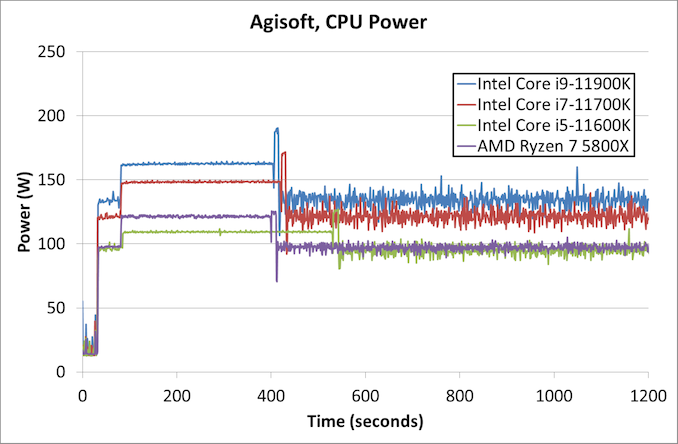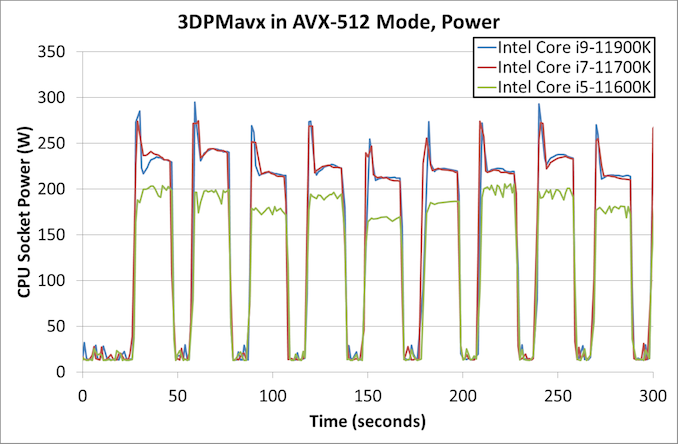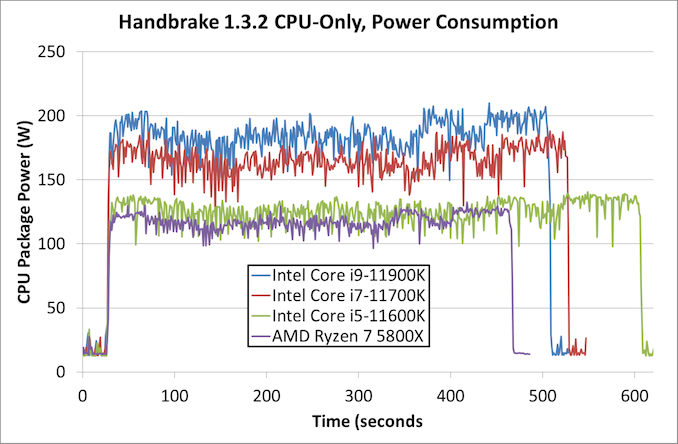Intel Rocket Lake (14nm) Review: Core i9-11900K, Core i7-11700K, and Core i5-11600K
by Dr. Ian Cutress on March 30, 2021 10:03 AM EST- Posted in
- CPUs
- Intel
- LGA1200
- 11th Gen
- Rocket Lake
- Z590
- B560
- Core i9-11900K
Power Consumption: AVX-512 Caution
I won’t rehash the full ongoing issue with how companies report power vs TDP in this review – we’ve covered it a number of times before, but in a quick sentence, Intel uses one published value for sustained performance, and an unpublished ‘recommended’ value for turbo performance, the latter of which is routinely ignored by motherboard manufacturers. Most high-end consumer motherboards ignore the sustained value, often 125 W, and allow the CPU to consume as much as it needs with the real limits being the full power consumption at full turbo, the thermals, or the power delivery limitations.
One of the dimensions of this we don’t often talk about is that the power consumption of a processor is always dependent on the actual instructions running through the core. A core can be ‘100%’ active while sitting around waiting for data from memory or doing simple addition, however a core has multiple ways to run instructions in parallel, with the most complex instructions consuming the most power. This was noticeable in the desktop consumer space when Intel introduced vector extensions, AVX, to its processor design. The concurrent introduction of AVX2, and AVX512, means that running these instructions draws the most power.
AVX-512 comes with its own discussion, because even going into an ‘AVX-512’ mode causes additional issues. Intel’s introduction of AVX-512 on its server processors showcased that in order to remain stable, the core had to reduce the frequency and increase the voltage while also pausing the core to enter the special AVX-512 power mode. This made the advantage of AVX-512 suitably only for strong high-performance server code. But now Intel has enabled AVX-512 across its product line, from notebook to enterprise, with the running AI code faster, and enabling a new use cases. We’re also a couple of generations on from then, and AVX-512 doesn’t get quite the same hit as it did, but it still requires a lot of power.
For our power benchmarks, we’ve taken several tests that represent a real-world compute workload, a strong AVX2 workload, and a strong AVX512 workload.
Starting with the Agisoft power consumption, we’ve truncated it to the first 1200 seconds as after that the graph looks messy. Here we see the following power ratings in the first stage and second stage:
- Intel Core i9-11900K (1912 sec): 164 W dropping to 135 W
- Intel Core i7-11700K (1989 sec): 149 W dropping to 121 W
- Intel Core i5-11600K (2292 sec): 109 W dropping to 96 W
- AMD Ryzen 7 5800X (1890 sec): 121 W dropping to 96 W
So in this case, the heavy second section of the benchmark, the AMD processor is the lowest power, and quickest to finish. In the more lightly threaded first section, AMD is still saving 25% of the power compared to the big Core i9.
One of the big takeaways from our initial Core i7-11700K review was the power consumption under AVX-512 modes, as well as the high temperatures. Even with the latest microcode updates, both of our Core i9 parts draw lots of power.
The Core i9-11900K in our test peaks up to 296 W, showing temperatures of 104ºC, before coming back down to ~230 W and dropping to 4.5 GHz. The Core i7-11700K is still showing 278 W in our ASUS board, tempeartures of 103ºC, and after the initial spike we see 4.4 GHz at the same ~230 W.
The Core i5-11600K, with fewer cores, gets a respite here. Our peak power numbers are around the 206 W range, with the workload not doing an initial spike and staying around 4.6 GHz. Peak temperatures were at the 82ºC mark, which is very manageable. During AVX2, the i5-11600K was only at 150 W.
Moving to another real world workload, here’s what the power consumption looks like over time for Handbrake 1.3.2 converting a H.264 1080p60 file into a HEVC 4K60 file.
This is showing the full test, and we can see that the higher performance Intel processors do get the job done quicker. However, the AMD Ryzen 7 processor is still the lowest power of them all, and finishes the quickest. By our estimates, the AMD processor is twice as efficient as the Core i9 in this test.
Thermal Hotspots
Given that Rocket Lake seems to peak at 104ºC, and here’s where we get into a discussion about thermal hotspots.
There are a number of ways to report CPU temperature. We can either take the instantaneous value of a singular spot of the silicon while it’s currently going through a high-current density event, like compute, or we can consider the CPU as a whole with all of its thermal sensors. While the overall CPU might accept operating temperatures of 105ºC, individual elements of the core might actually reach 125ºC instantaneously. So what is the correct value, and what is safe?
The cooler we’re using on this test is arguably the best air cooling on the market – a 1.8 kilogram full copper ThermalRight Ultra Extreme, paired with a 170 CFM high static pressure fan from Silverstone. This cooler has been used for Intel’s 10-core and 18-core high-end desktop variants over the years, even the ones with AVX-512, and not skipped a beat. Because we’re seeing 104ºC here, are we failing in some way?
Another issue we’re coming across with new processor technology is the ability to effectively cool a processor. I’m not talking about cooling the processor as a whole, but more for those hot spots of intense current density. We are going to get to a point where can’t remove the thermal energy fast enough, or with this design, we might be there already.
I will point out an interesting fact down this line of thinking though, which might go un-noticed by the rest of the press – Intel has reduced the total vertical height of the new Rocket Lake processors.
The z-height, or total vertical height, of the previous Comet Lake generation was 4.48-4.54 mm. This number was taken from a range of 7 CPUs I had to hand. However, this Rocket Lake processor is over 0.1 mm smaller, at 4.36 mm. The smaller height of the package plus heatspreader could be a small indicator to the required thermal performance, especially if the airgap (filled with solder) between the die and the heatspreader is smaller. If it aids cooling and doesn’t disturb how coolers fit, then great, however at some point in the future we might have to consider different, better, or more efficient ways to remove these thermal hotspots.
Peak Power Comparison
For completeness, here is our peak power consumption graph.

Platform Stability: Not Complete
It is worth noting that in our testing we had some issues with platform stability with our Core i9 processor. Personally, across two boards and several BIOS revisions, I would experience BSODs in high memory use cases. Gavin, our motherboard editor, was seeing lockups during game tests with his Core i9 on one motherboard, but it worked perfectly with a second. We’ve heard about issues of other press seeing lockups, with one person going through three motherboards to find stability. Conversations with an OEM showcased they had a number of instability issues running at default settings with their Core i9 processors.
The exact nature of these issues is unknown. One of my systems refused to post with 4x32 GB of memory, only with 2x32 GB of memory. Some of our peers that we’ve spoken to have had zero problems with any of their systems. For us, our Core i7 and Core i5 were absolutely fine. I have a second Core i9 processor here which is going through stability tests as this review goes live, and it seems to be working so far, which might point that it is a silicon/BIOS issue, not a memory issue.
Edit: As I was writing this, the second Core i9 crashed and restarted to desktop.
We spoke to Intel about the problem, and they acknowledged our information, stating:
We are aware of these reports and actively trying to reproduce these issues for further debugging.
Some motherboard vendors are only today putting out updated BIOSes for Intel’s new turbo technology, indicating that (as with most launches) there’s a variety of capability out there. Seeing some of the comments from other press in their reviews today, we’re sure this isn’t an isolated incident; however we do expect this issue to be solved.













279 Comments
View All Comments
Qasar - Friday, April 2, 2021 - link
no but i am sure you are as YOU are the one that keeps moving the goal posts, not me. YOU said PC gaming was an expensive hobby, so i suggested a console, so you can save money vs a comp, as this seems to be you WHOLE POINT, to save money." I also never said use the iGPU to game, because gaming on a iGPU, basic dGPU, or APU will be a crappy experience on modern titles. " no but you INSINUATED that you did, so who is the idiot ? and to go buy a 11600k and NOT use it for gaming, as YOU IMPLIED, (cause if you are not going to game with and need the cores, the 5600X is clearly the better choice, as its multi threaded performance, is above the 11600k) is well, whats that word you keep crying about, oh yea, E waste. if that is the case and you dont intend on gaming then getting a MUCH cheaper cpu, with your beloved igp, would be a better option.
as i said in my other post, as you are now resorting to name calling, is further shows, you are wrong, and your whole point, has been proved wrong by giving other options, so, run along little child, when you can talk with out resorting to name calling, then come back
vanish1 - Monday, April 5, 2021 - link
please stop, you keep being wrong.why would anyone buy a console if they intend to build a PC or PC game? Do you understand what saving money means? It means not spending it.
Once again, I never said gaming on a PC, I said build a PC. You keep assuming incorrectly. As such, see original post.
1_rick - Tuesday, March 30, 2021 - link
Ridiculous. Bottom-tier dGPUs are $50-60, even on Newegg. Sure, they're worthless for gaming, but they'll be fine for office work and basic web browsing.vanish1 - Wednesday, March 31, 2021 - link
Okay so spend $60 on overpriced E-waste that you will have to eventually replace anyways when that money could have been put into a higher tier CPU, saved towards your actual GPU, or spent on other parts of the PC build.Who wants to spend $60 on a GPU just to make their CPU work? Its ridiculous.
Qasar - Wednesday, March 31, 2021 - link
who says you have to throw it out ? you COULD keep it for emergencies, put it in another comp, or, um i dunno, sell/give it to a friend who could use a vid card for what ever reason.you say intel is the only option/best option, but you obviously havent considered anything thing else.
vanish1 - Wednesday, March 31, 2021 - link
The fanboys that exist here crack me up. Constant complaining about the GPU market, overpriced and out of stock, yet willing to add fuel to that fire just to have an AMD CPU grace your presence; the hypocrisy is outstanding. I never said throw it out, it just ends up being E-waste at the end, but your mindset is the issue with the disposable culture we live in. Beyond that, I dont want to go through the hassle of buying and selling multiple cards, Ill buy one when its time, plug it into my system, and be done. Put it into another computer? So build another computer on top of the one youre already building, not alot of sense there. Give it to a friend, why would you waste your friends time with a 710 gt? Sounds more like trying to pass the buck.29a - Wednesday, March 31, 2021 - link
Did you really just call other people fanboys?Qasar - Wednesday, March 31, 2021 - link
thats what i thought, looks like there is a new intel fanboy on here :-) maybe he is upset cause rocket lake is well, pathetic ( going by GN's review )vanish1 - Thursday, April 1, 2021 - link
I mean when people like yourself and 29a cant comment on the point I'm making and instead try to dunk on me for calling out Intel shills when I see them, it clearly shows who is right (me) and who is wrong (both of you)BushLin - Thursday, April 1, 2021 - link
Your argument is to PC gaming enthusiasts that they should enjoy the performance they had in their gaming rig over a decade ago but on modern titles because there is a GPU shortage. If you truly cared about ewaste, why not just continue using your old rig rather than buy a dead end motherboard to have a worse experience?